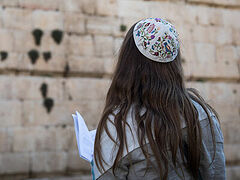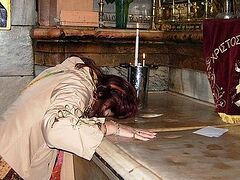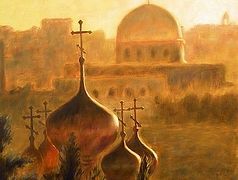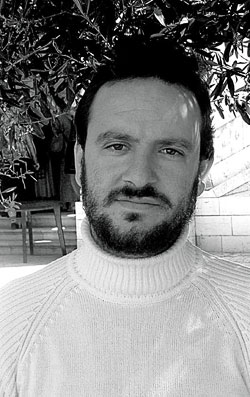 A tour guide like Raphael is hard to find. Who can talk about the Holy Land better than the person who was born and raised there? Raphael Musan-Levi is a native Jerusalemite who conscientiously converted to Orthodoxy. He is well versed in theology and history and speaks beautiful and idiomatic Russian. Luckily, I had a voice recorder with me, so while our pilgrims were handing in the memorial requests in the Church of Mary Magdalene, Raphael and I sat on a bench in the monastery park and had a chat. This interview is now available for the readers of Pravoslavnyi Vestnik [the original article was published in Pravoslavnyi Vestnik]. We also provided some quotes from Raphael’s tour programs.
A tour guide like Raphael is hard to find. Who can talk about the Holy Land better than the person who was born and raised there? Raphael Musan-Levi is a native Jerusalemite who conscientiously converted to Orthodoxy. He is well versed in theology and history and speaks beautiful and idiomatic Russian. Luckily, I had a voice recorder with me, so while our pilgrims were handing in the memorial requests in the Church of Mary Magdalene, Raphael and I sat on a bench in the monastery park and had a chat. This interview is now available for the readers of Pravoslavnyi Vestnik [the original article was published in Pravoslavnyi Vestnik]. We also provided some quotes from Raphael’s tour programs.
—Raphael, your Russian is very good. It sounds as if you lived in Russia for a long time.
—I was born in Jerusalem. My father was born in Jerusalem too, while my mother is originally from England. Many generations of my family lived in Jerusalem. I don’t really speak Russian that well, I often make mistakes, mix up the cases, and so on. But I do know Russian, probably because I have a Russian soul.
I was eleven years old when I came across a Russian textbook for English speakers. It had a Russian alphabet in it. I was bored, so I started studying it. I wasn’t sure why I was doing it—I lived in Jerusalem and my family was Jewish. I guess Russian language played a certain role in my conversion to Orthodoxy. The first prayer book I bought was in Church Slavonic. Later I found prayer books in English and Hebrew, but I still say my prayers in Russian. Since I’m a member of the Jerusalem Church, I also pray in Greek.
Somehow, I was always drawn to Russia. I admired it. I like Russian literature very much. At first, I read the translations, then I moved on to reading the originals. I also worked in a Russian language theater. I learned my roles in Hebrew at first, and then in Russian. Sometimes I learned the roles in Russian right away. That is why I have a good vocabulary. As far as idiomatic expressions are concerned, I learned them from my wife who is a Muscovite.
—Where did you meet your better half?
—We met at the theater where I was performing. Our daughter is two years and seven months old now. She also speaks Russian. She understands English and we want her to know this language too, because her grandmother speaks English. She must know Hebrew also, of course. And if she picks up some Greek while talking to Greek nuns, it would be great.
—Is it natural for people to speak so many languages here?
—A person living in Jerusalem simply must know Arabic, Greek, Russian and Hebrew. Jerusalem is a city that unites the people of various tribes and beliefs, and, most importantly, Orthodox people of various ethnicities. When Orthodox Christians go on the pilgrimage to Jerusalem, it is important for them to feel that Orthodoxy is a universal religion, rather than regional. Naturally, various people have their own customs and traditions. But the Church Rule and the Gospel are for everybody. There could be some minor differences, but they are not important. Holy Communion is one and the same for everyone. One can particularly feel this in Jerusalem. I’ve visited cities in England and France and I couldn’t get that feeling there.
—What did you find attractive in Orthodoxy?
—It was very easy for me. I’ve been a believer since childhood. I knew the Old Testament and Jewish prayers. I was never an atheist. So, conversion to Orthodoxy was very natural for me. All my life before that was a catechesis, a preparation for the Orthodox faith. I’m surprised that most of the believing Israelis don’t understand it. But for me it was a simple and natural transformation. This may sound like an exaggeration, since most of the people in this country do not have good feelings toward Christianity and some even openly hate Christ and Christians.
I never had this attitude. In this sense, my family was unusual. We always communicated with various people, even though my parents were believing Jews. Our neighbors were Protestants, some of my father’s coworkers were Muslim—we always treated everybody well. Yet we knew that Judaism was our religion.
 The Church of the Resurrection, Jerusalem. Photo by A. Pospelov/Pravoslavie.ru
The Church of the Resurrection, Jerusalem. Photo by A. Pospelov/Pravoslavie.ru
When I became a teenager, I realized that either all of this was made up nonsense or all the Old Testament prophesies were indeed about the coming of Christ, and they all came true when Christ was born, crucified and resurrected. Basically, I knew the Gospel when I was a teenager. But it was St. Paul’s Epistle to the Romans that finally converted me to Orthodoxy. I believe that when you face some difficulties in your life, it is very useful to read St. Paul’s epistles, for there you can find answers to all your questions. So, you can say that I was converted by St. Paul. He used to be a Pharisee, a devoted Jew and a persecutor of Christians, and then Christ appeared to him. St. Paul’s example and his epistles opened this world to me.
Why did I choose Orthodoxy out of all possible denominations? Because only in Orthodoxy I could find the continuation of the Church of the Old Testament and it was the only denomination that had apostolic succession. It is not because our Church is better or worse than others. Sometimes people say, “Yes, I would like to be a Christian, but they have such problems… And their priests and Patriarchs are so and so…” I converted to Orthodoxy when there were big problems and even scandals in our Church. But I didn’t convert to Orthodoxy for the sake of a good or a bad Patriarch; I did it to come to Christ.
I wasn’t baptized right away. At first, I simply went to the Holy Sepulcher. You can say that the divine grace of this holy site was very important. There I met some priests who invited me to attend the Divine Liturgy that was celebrated at night. Before that, I thought that people in the Church of the Holy Sepulcher only wandered aimlessly, but during that Liturgy I saw the Holy Sepulcher in a different light. It is different during the day when there are tourists wandering around; however, at night, during the Divine Liturgy, everything is the way it should be.
It took a long time for me to make sure that I really wanted to convert. You can say that I went through a certain catechesis and became a practicing Christian even before I was baptized, which was also important. I’ve learned the prayer book and more or less knew the Liturgy—in Russian, of course. The priests also participated in this process. I can’t say that they were training me in any special way, but it was their prayers that ultimately got me to baptism. After my baptism, I found a spiritual father. He is from the Jerusalem Church, the Jerusalem Patriarchate. He guided me, and it was he who gave me his blessing to work with pilgrims. I am thankful to God that He didn’t leave me without help—I was baptized, I met people who are praying for me, I have my wife and my daughter as well as my work with pilgrims, which is very inspiring for me.
 Photo by Anton Pospelov/Pravoslavie.ru
Photo by Anton Pospelov/Pravoslavie.ru
—It seems to me that working with pilgrims is not easy.
—When we see Orthodox pilgrims from Russia or other countries here in the Holy Land, and it is a big help for us. Our country is predominantly Jewish and Muslim, and most of the people belong to those religions. That is why it is important when Orthodox people from other countries come here and show the local Orthodox that they are not alone and that Jerusalem still holds an important part in the hearts of the Orthodox people from all over the world, because it is our spiritual capital.
—Is there anything special about the pilgrims from Russia?
—Pilgrims from Russia are very congenial. You can tell that they love the Holy Land. But because life in Russia is quite hectic nowadays, when Russians come here you can feel the energy of the modern world in them right away. Usually, it takes two or three days for people to get accustomed to the different rhythm of life in the Holy Land. But by the time they get used to it, it is time for them to return home. So, it is good, of course, to see pilgrims who have kept their Russian spirit intact, because sometimes people don’t have that Russian soul even though they were born in Russia.
Thankfully, I mostly work with “Radonezh”, and when I work with other pilgrimage services, I select them carefully. It is difficult to talk about holy sites with people who don’t know and don’t want to know anything and who for some reason bought a ticket to the Holy Land instead of going to a resort in Turkey. But I’m happy to work even with these people, because sometimes people change. It shows that despite their superficial atheism, they have very deep Orthodox roots. Maybe they have ancestors who pray for them, or maybe their ancestors were saints, who can tell?
Naturally, besides having theological knowledge, a guide should be able to solve various problems that may arise here. Thank God, I’m getting more and more experienced. When I just started working here, I made big mistakes, so I’m very sorry and ask forgiveness of all people whom I offended by my behavior or misunderstanding.
 The Edicule. Church of the Resurrection, Jerusalem. Photo by Anton Pospelov/Pravoslavie.ru
The Edicule. Church of the Resurrection, Jerusalem. Photo by Anton Pospelov/Pravoslavie.ru
—Raphael, what is the most important thing about the pilgrimage to the Holy Land?
—It is important for people to change their ways of life after coming here. If a person returns from the Holy Land and continues to live just like they did before the pilgrimage, it is very bad.
—Is pilgrimage a time of temptations?
—When I talk with pilgrims, I see more things that give me joy and hope than any temptations. Even with this group there were various temptations, but I see people receiving divine grace. Even though it is still difficult for them, because something wasn’t provided to them or some event wasn’t well-organized; but these are trifling matters, there are more important things.
Temptations are always there, and that is good. The enemy uses various ways to ruin people’s impressions from the trip. But there is nobody and nothing that can separate us from God. The enemy attempts to present some hurdles, but people cannot be stopped, if they have a heart and desire to overcome them. That’s all it takes. If a person travelled to the Holy Land instead of Honduras or Hawaii, it means that this person needed to do it, even if he or she didn’t understand it. Every man is a whole world. And each group of pilgrims is a whole world too.
Some pilgrims have experienced serious tragedies and come here in hope of getting help. Some people come because their spouses are non-believers and they hope that things will change after this trip. Sometimes it happens, but doesn’t happen always, because there’s divine grace, and there’s man’s will. God does not force people to be saved—it depends on our heart and on the choices we make. You can’t force a person to be religious, even if you love this person very much. For example, I love my mother very much, but I can’t force her to become an Orthodox Christian. She’s not Orthodox, she’s not baptized. I love her and hope that God will have mercy on her. Although, I know that it is very difficult for unbelievers and people who weren’t baptized.
It is the same with other people. They could be Christian, but fail to understand anything. I can love them very much, but it doesn’t mean that everything is going to be alright with them. Sometimes women bring their children here thinking that if they force them to visit holy sites, their children will become Christian. However, one needs to change his or her way of life to do that.
I think it is useful that people who come here feel the simplicity that has been preserved here in both social and church life. We have clerics with diverse personalities, but most of them are easily accessible. Here pilgrims see people who basically lead a rural way of life, and if after returning home a pilgrim would use the harmful modern technologies at least a little bit less, it would be good because so many souls are lost because of these technologies. Elder Paisios the Athonite also used to say that one must become a different person after a pilgrimage.
Interview by Svetlana Ladina, Jerusalem
Excerpts from Raphael’s tour stories
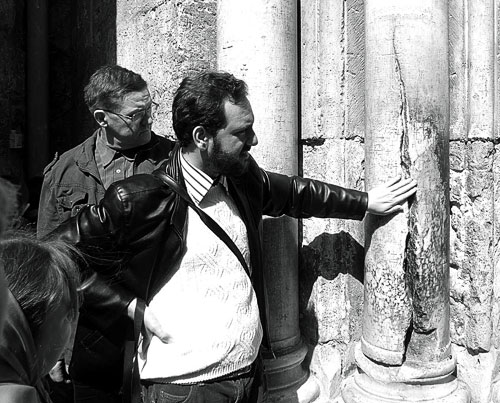
One of the pilgrims complains about the tour and living accommodations. Trying to help the guide out, another pilgrim notes that Jesus Christ used to sleep here on the ground and didn’t complain.
“Yes, but Our Lord didn’t have to pay for the air tickets…”, says Raphael.
***
Here’s what Raphael said after his group came out of the Church of the Holy Sepulcher:
“I was silent while we were near Golgotha because any conversations there are inappropriate. Now I can continue my tour.”
The Wailing Wall:
“We are not going to the Wailing Wall. Do you understand what the wailing is about? “Oy vey, Jesus, why did you come? Now our temple is destroyed because You said that there shall not be left here one stone upon another!”
Simplicity:
“Sometimes pilgrims ask me:
“Does the Patriarch of Jerusalem go to the Holy Sepulcher along these streets?
“Yes, why?”
“They are so dirty!”
“Yes, but the Patriarchate hasn’t dug any underground tunnels. Thankfully, this city hasn’t been turned into a museum, so we can see everything here.”
***
In the Church of the Holy Sepulcher:
“It is not the Church that makes decisions here, it’s the police.”
Archeology:
“In Greece, St. Helena, the equal-to-the-apostles empress, is considered to be the divine patron of Orthodox archeologists. It was she who discovered all these sites, found the true Holy Cross, and did everything to make it available to people for worship. As opposed to a secular archeologist, an Orthodox archeologist has a totally different objective. A secular archeologist finds something just because he’s curious or because he wants to become famous. An Orthodox archeologist also works for the sake of science, but first and foremost he’s looking for holy sites so that believers could pray there.”
Status quo:
“Nowadays the clergy do not have to pay anything to celebrate the Divine Liturgy in the Church of the Holy Sepulcher, Thank God. This is due to the established order. The order is not ideal, of course, but it is better than what we had before. Established in the 1860s, this order is known as the Status Quo. The Status Quo was established at the urging of Great Britain, France, Germany, and Russia. These countries told the Turks that the practice of giving the right to perform the Liturgy for payment must be discontinued. The areas were divided among the Orthodox, the Armenians and the Catholics. Most belong to the Orthodox. However, the keys are kept by the Turks [that is, the Muslims]. Have you noticed a man in the church who sits on a bench reading a newspaper? He is the key keeper of the Church of the Holy Sepulcher. He’s not a member of the clergy, just a regular Muslim who opens and closes the church. So, the keys are kept by the Muslims, rather than by the Catholics, the Orthodox or the Armenians. This is done to prevent any disputes among us. After the Status Quo was introduced, one of the workers or the monks left this ladder here. Up to this day the Catholics, the Orthodox and the Armenians haven’t agreed about who has the right to remove it. So the ladder is still there. You can even see that ladder on the black-and-white photographs taken before 1917.”
Interdenominational relations
“You can’t do anything new here. There is a procedure for censing and holding processions. If someone breaks the rules, it sometimes leads to fighting. If an inexperienced deacon is censing in the wrong place or at the wrong time, it may cause a scandal. Sometimes people just shout at each other, but it may escalate to actual fighting. It happens, unfortunately. It is what they call the human factor. Very rarely a council is held which includes the Orthodox, the Armenians, the Catholics and the Muslims. It is difficult to maintain order there. Naturally, the Armenians and the Catholics always want to get everything, while the Orthodox try to keep the holy sites in their hands.”
Enthusiasm
“Two years ago at the foothills of Mt. Tabor they had a disco with laser show. The lights were reflected even on the walls of the church. Suddenly one of the pilgrims exclaimed, “It’s a blessing!” And people believed it. If people think that disco lights are a blessing, then things are not so good.”
Near one of the holy sites in the Church of the Holy Sepulcher:
“Everyone who has come here has found a reason why have a right to chop off pieces of this rock, and that is why it had to be covered by glass.”
Temptations
“Sometimes when people come to Jerusalem, they expect to see the New Jerusalem as if they were in heaven. Sometimes they even get something that is similar to a psychological disorder. It is called the Jerusalem Syndrome. Mostly it happens to Americans and those who think that they are King David or Prophet Isaiah. The Russians have it in a different way. For example, Nikolai Vasilyevich Gogol on his pilgrimage to Jerusalem thought he would see God’s Angels walking in the streets. Instead, he saw an oriental city with its temptations and problems. Jerusalem is a spiritual place. However, you can see many confusing things here. We need to remember that we’re not in heaven yet. Yes, it is a sacred and blessed place, but you need to remember that everything here is taken to the extreme. The problems in the Orthodox world and in the world in general are more noticeable here. At home, people don’t notice it, but in Jerusalem, they feel that sometimes there is mutual suspicion among the Orthodox people and that it is even stronger among the churches of different denominations.”
Triumph of Orthodoxy
“The Turks were making money off the Holy Sepulcher, and let those who paid more use the church. The Armenians always wanted to be the first to get the Holy Fire. Let me say right away that when I say “the Armenians” I don’t mean ethnic Armenians but members of the Armenian Church. Usually, everybody is praying together. However, it is the Orthodox Patriarch who receives the Holy Fire when it descends, and shares it with other non-Orthodox bishops who in turn share it with their laity. But the Armenians wanted to be the first to receive the Holy Fire. So, five hundred years ago they paid the Turks to let them in first. The Turks did so, and the Armenians went to the Holy Sepulcher. When the Orthodox Patriarch came, he was told to stay behind the threshold and wasn’t allowed to walk in. The Holy Fire didn’t descend when the Armenian bishop prayed in the area where this was supposed to happen. Instead, there was flash by the worn column where the Orthodox Patriarch was standing and it was there that he received the Holy Fire. The Holy Sepulcher is a sacred place and God wants us to pray in sprit and in truth. It doesn’t matter where you are, what is important is for you to have the right prayer in your heart and then Gold will help you even when it seems impossible. He can send the Holy Fire even to the North Pole, not only to Jerusalem. The main thing is to have the flame of the prayer in your heart. And that split column is a sign that Orthodoxy is the right faith. That is why we call this column the Triumph of Orthodoxy.
Chasing miracles
We used to have the icon of the Mourning Mother of God here in our Savior’s Sepulcher. In the 1980s, a Protestant fanatic decided to destroy it, and only the top part of the icon survived. After that incident, a grating was installed to protect the icon. It was really a miracle-working icon. The problems with it started in mid-nineties when a lot of pilgrims from Russia started coming to Jerusalem. The Russians started the rumor that the Mother of God on the icon was allegedly opening and closing her eyes. The rumor was then picked up by the Greeks. On that icon, the Mother of God is depicted looking down and Her eyelids are half-lowered. So, when a light falls in a certain way, it looks like the eyes are opening as if in response to the praying person. But this belief was actually distracting people from praying. During the Divine Liturgy, some people were praying and receiving the Holy Communion, while others were trying to see whether the Mother of God on the icon was opening or closing Her eyes. As I’ve mentioned earlier, the icon was protected by the grating and it was quite dark there, so people were bringing the candles very close to the icon to see better. As a result, the icon had to be sent to the restorers—the “pious” pilgrims nearly burned it. There’s nothing good about such miracle chasing. The greatest miracle happens during the Divine Liturgy, when bread and wine are transformed into the Body and Blood of Our Lord Jesus Christ. There’s no greater miracle. Even if Archangel Raphael gives me wings and I am be able to fly, it will still be a much lesser miracle than the Eucharist that happens daily in our churches.

